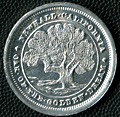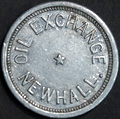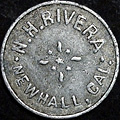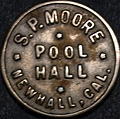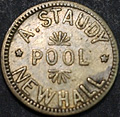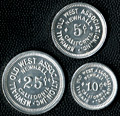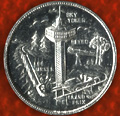|
|

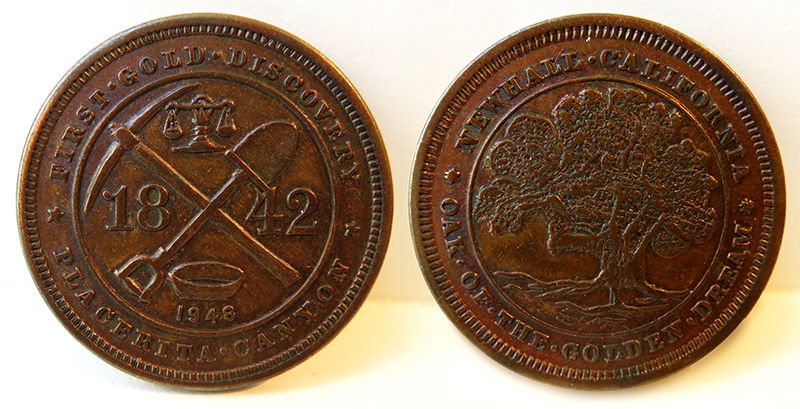
Click image to enlarge
As the state of California prepared to celebrate the 100th anniversary of James Marshall's discovery of gold in John Sutter's millrace, Santa Clarita Valley residents didn't want anyone to forget where California's first documented gold discovery was made six years earlier: right here in Placerita Canyon. One of those local residents was Ernie Hickson, owner of the Placeritos movie ranch (which was renamed Melody Ranch after Gene Autry bought the place). So, in 1948, Hickson ordered up a batch of medals from the Los Angeles Stamp & Stationery Co. (commonly known as Los Angeles Rubber Stamp Co., its name prior to 1935). L.A. Rubber Stamp manufactured most of the merchant tokens that were popular throughout the American West at the time. Hickson's medals read "FIRST GOLD DISCOVERY / PLACERITA CANYON / 1842" with a miner's pick, shovel, pan and scales and the date, 1948, on one side. The other side bore the words, "NEWHALL, CALIFORNIA / OAK OF THE GOLDEN DREAM" and a likeness of the famous tree — which you can see when you visit the Placerita Canyon Nature Center. It's about a quarter-mile west of the park entrance, adjacent to Placerita Creek. Hickson must have ordered and reordered the tokens, because they are known in three original varieties — bronze (or bronze alloy), brass, and gilt (gold-washed) bronze or brass. Considering their survival rates today, he must have ordered a couple thousand of them. There is a fourth and rarer variety: a uniface "Anillo restrike" in aluminum, made in 1968 (explanation below). To publicize the Placerita gold discovery, Hickson sent his 1842/1948 medals to politicians and museums. The rest he sold for 25 cents apiece trough an agent — Henry "Hank" Dreher, who ran the American Theatre on Spruce Street. Hickson was, or quickly became, an old pro at ordering medals from L.A. Rubber Stamp. He had tokens made in 5, 10, 25 and 50 cent denominations for the Fourth of July celebrations held at his movie ranch in 1949, 1950 and 1951. They came to be known as "Slippery Gulch tokens" in acknowledgement of the persona his ranch assumed for the occasion. Hickson may also have been responsible for the similarly denominated Newhall Old West Association tokens that were used when Independence Day was celebrated in grand style at the French Village. The Fourth was celebrated at the French Village in 1948 before moving to Hickson's Ranch, and it returned there following Hickson's death in January 1952. We know the Newhall Old West tokens were used in 1952-53; we don't know if they were used in 1948, but so many of them were made that there was ample supply for all those years. Hickson might have ordered them by the thousands in 1948. (Note: A "token" is a coin-like issue that bears a stated value, be it a denomination or "Good For One Beer." A "medal" has no stated value.) Postscript: In 1968, Anillo Industries of Orange, Calif., purchased the inventory of Los Angeles Stamp & Stationery Co. and struck uniface (one-sided) aluminum examples from that company's 3,492 original dies, including this Placerita gold discovery medal. It is believed that only four sets of the restrikes were made, although one source puts the number of Anillo restrikes at 25 each.
LW2952: 9600 dpi jpeg from digial images of original medal purchased 2017 by Leon Worden.
|
Fremont for President 1856 "Jessie's Choice"
Oil Exchange Saloon Tokens 1890s (x2)
Nick Rivera Saloon Token 1890s
S.P. Moore Pool Hall Token 1890s
Staudy's/Stauty's 1890s (x2)
(James) Jeffries & Kipper 1907-1910
John C. Fremont 1913
Thornton Edwards / St. Francis Dam 1928
Placerita Gold Discovery 1842/1948
Placeritos Ranch 1949-51 (x4+3)
1968 Anillo Restrikes of
Newhall Old West 1952-53
Ace Cain's 1950s/60s
Cliffie Stone 1960s
Callahan's 1960s (x2)
Joe Kapp CFL 1963
Scott Newhall's Anguilla Dollar 1967
Whittaker-Bermite Service Award 1967-1987
Magic Mountain 1971
Signal Ingot ~1973
Elks Lodge 2379
Margo $25, 1980s
Lechler's Piru Museum
Top Of The Vine Casino Chips 1995-99
|
The site owner makes no assertions as to ownership of any original copyrights to digitized images. However, these images are intended for Personal or Research use only. Any other kind of use, including but not limited to commercial or scholarly publication in any medium or format, public exhibition, or use online or in a web site, may be subject to additional restrictions including but not limited to the copyrights held by parties other than the site owner. USERS ARE SOLELY RESPONSIBLE for determining the existence of such rights and for obtaining any permissions and/or paying associated fees necessary for the proposed use.



